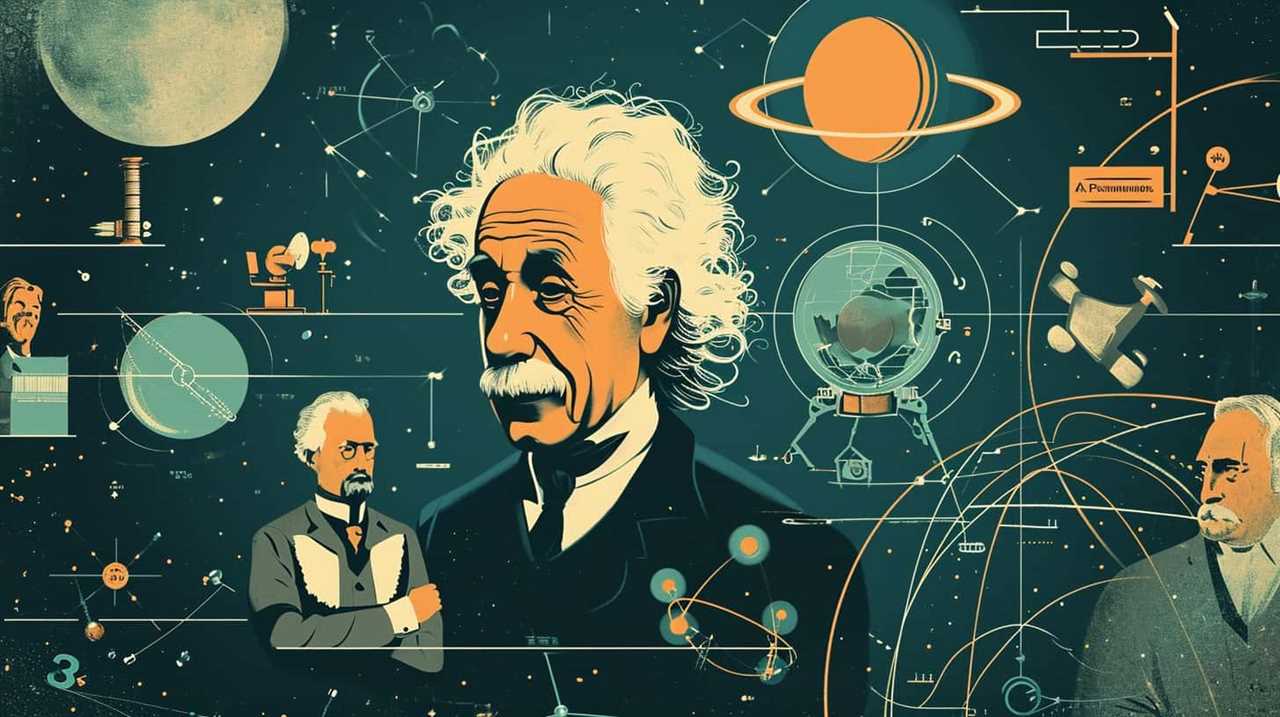Prepare yourself to explore the fascinating realm of language theory with our curated selection of impactful quotes from famous linguists! We have carefully examined the writings of the most influential thinkers in the field to present you with perspectives that will question your beliefs and inspire your creativity.
From Ferdinand De Saussure’s groundbreaking ideas on the structure of language to Noam Chomsky’s revolutionary theories on syntax, prepare to be amazed by the innovative thinking that has shaped our understanding of how we communicate.
Ludwig Wittgenstein, Roman Jakobson, John Searle, Michael Halliday, William Labov, Charles Hockett, and Edward Sapir have all contributed their unique perspectives to the fascinating puzzle of language.
Get ready to explore their profound thoughts and embark on a journey of linguistic innovation!
Key Takeaways
- Ferdinand De Saussure revolutionized our understanding of language by introducing the concept of linguistic signs and their arbitrary relationship between signifiers and signifieds.
- Noam Chomsky’s generative grammar transformed our understanding of language by highlighting the underlying structures and principles that allow humans to generate an infinite number of grammatically correct sentences.
- Ludwig Wittgenstein emphasized the dynamic nature of language as a form of human activity, highlighting the importance of language games played within specific social contexts and the connection between language and everyday life.
- Roman Jakobson’s influential ideas on communication highlighted the role of context in understanding meaning and emphasized the different functions of language, such as expressive and referential, which can be analyzed using a spectrum of colors representing different forms of expression.

Ferdinand De Saussure’s Insights on Language
One of our favorite linguists, Ferdinand De Saussure, provides valuable insights on language that we’ll explore in this article. Saussure’s influence on structural linguistics has had a profound impact on the field. His concept of linguistic signs, in particular, has revolutionized the way we understand language.
According to Saussure, language is a system of signs that consists of two components: the signifier and the signified. The signifier is the physical form of the sign, such as a spoken or written word, while the signified is the concept or meaning associated with the sign. Saussure argued that the relationship between the signifier and the signified is arbitrary and conventional, meaning that it’s established by social agreement rather than any inherent connection between the two.
This concept of linguistic signs has significant implications for our understanding of language structure. It highlights the importance of studying the relationships between signs within a language system, rather than focusing solely on individual signs or words. By examining these relationships, linguists can uncover the underlying structures and patterns that govern language.
Saussure’s ideas have sparked numerous innovations in the field of linguistics, particularly in the realms of semiotics and structuralism. His emphasis on the structural aspects of language has paved the way for further exploration and understanding of language systems. By analyzing the intricate web of linguistic signs, researchers can uncover the underlying principles that shape language and its usage.

Noam Chomsky’s Groundbreaking Linguistic Theories
Continuing our exploration of renowned linguists’ insights on language, we delve into Noam Chomsky’s groundbreaking linguistic theories. Chomsky is widely known for his contributions to the field of linguistics, particularly his development of generative grammar and transformational syntax.
Chomsky’s generative grammar revolutionized the way we understand language. He argued that language isn’t simply a collection of words and rules, but a complex system with underlying structures and principles. According to Chomsky, humans possess an innate ability to generate an infinite number of grammatically correct sentences, which he called the ‘creative aspect of language.’
Transformational syntax, another key aspect of Chomsky’s theories, focuses on the transformational processes that occur in the formation of sentences. Chomsky proposed that sentences undergo transformations to derive different structures while preserving their underlying meaning. These transformations allow for the generation of a wide range of grammatically correct sentences from a finite set of rules.
Chomsky’s theories have had a profound impact on linguistics and have paved the way for further research in the field. His emphasis on the innate nature of language and the underlying structures has challenged traditional views and sparked new avenues of exploration. By understanding the fundamental principles of language, Chomsky’s work has opened doors to innovative approaches in linguistics.

Ludwig Wittgenstein’s Perspective on Language Use
Now let’s explore Ludwig Wittgenstein’s perspective on language use, building upon Chomsky’s groundbreaking linguistic theories.
Wittgenstein believed that language isn’t merely a system of rules, but a complex and dynamic form of human activity. Here are three key insights from Wittgenstein’s theories:
- Wittgenstein’s language games: According to Wittgenstein, language isn’t a fixed set of rules, but a collection of language games that are played within specific social contexts. These language games involve the use of words, gestures, and other forms of communication to achieve specific purposes. Each language game has its own rules and conventions, and understanding language requires engaging in these games.
- Language as a form of life: Wittgenstein argued that language is deeply embedded in our everyday lives and is intimately connected to our experiences, actions, and social interactions. He believed that the meaning of words isn’t determined by their referents, but by their use within a particular form of life. Language, for Wittgenstein, is a tool for expressing and understanding the experiences and practices that make up our shared existence.
- Language and innovation: Wittgenstein’s perspective on language use encourages us to think beyond traditional notions of language and embrace innovation. By recognizing language as a dynamic and context-dependent activity, we can explore new ways of using language to communicate and express ourselves. Wittgenstein’s ideas challenge us to break free from rigid linguistic structures and explore the creative possibilities that language offers.
With Wittgenstein’s perspective on language use in mind, let’s now delve into Roman Jakobson’s influential ideas on communication.

Roman Jakobson’s Influential Ideas on Communication
As we transition to discussing Roman Jakobson’s influential ideas on communication, it’s important to explore the ways in which he expanded upon previous linguistic theories. Jakobson’s communication model revolutionized our understanding of language by emphasizing the various functions it serves in human communication. According to Jakobson’s theory of linguistic functions, there are six key elements involved in any act of communication: the addresser, the addressee, the message, the context, the contact, and the code. Each of these elements plays a crucial role in the process of communication.
Jakobson’s communication model goes beyond the mere transmission of information and delves into the intricacies of human interaction. It highlights the importance of context and the role it plays in shaping meaning. Jakobson’s theory also recognizes the significance of the code, or the shared system of language, in facilitating effective communication. By considering these different elements, Jakobson’s model provides a comprehensive framework for analyzing and understanding the complexities of communication.
Innovation-seeking audiences will find Jakobson’s ideas on communication particularly intriguing. His emphasis on the multiple functions of language and the interplay between different elements opens up new possibilities for exploring communication in various contexts. Jakobson’s communication model invites us to question and challenge traditional notions of language use, paving the way for fresh perspectives and innovative approaches to understanding human communication.

John Searle’s Examination of Speech Acts
While exploring the influential ideas of renowned linguist John Searle, we delve into his examination of speech acts. Searle’s critique of speech act theory has had a significant impact on the field of linguistics and has opened up new avenues for understanding the complexities of language and communication.
Here are three key points about Searle’s examination of speech acts:
- Critique of Austin’s theory: Searle challenged J.L. Austin’s original theory of speech acts, arguing that it was incomplete and failed to account for the illocutionary force of utterances. He emphasized the importance of intentionality and how it shapes the meaning and effectiveness of speech acts.
- Classification of speech acts: Searle proposed a classification system for speech acts, dividing them into five categories: representatives, directives, commissives, expressives, and declaratives. This framework provides a comprehensive understanding of the different types of speech acts and their functions in communication.
- Applications of speech act theory: Searle’s examination of speech acts has had wide-ranging applications in fields such as pragmatics, philosophy, and artificial intelligence. It has helped researchers and scholars better understand how language is used to perform actions, negotiate meaning, and establish social relationships.

Benjamin Lee Whorf’s Hypothesis on Language and Thought
Occasionally, we ponder Benjamin Lee Whorf’s hypothesis on the relationship between language and thought. Known as the Whorfian hypothesis, it suggests that the language we speak shapes our cognition and perception of the world. According to Whorf, language isn’t merely a tool for communication but a fundamental determinant of how we think and understand reality. This idea challenges the traditional view that language is a neutral medium through which we express our thoughts.
Whorf argued that different languages encode different concepts, and therefore speakers of different languages perceive and interpret the world differently. For example, he highlighted how the Hopi language, which lacks grammatical structures for expressing time, influences the way Hopi speakers conceptualize time as a continuous process rather than discrete moments. Whorf’s hypothesis implies that language not only reflects our thoughts but also actively shapes and constrains our cognitive processes.
While the Whorfian hypothesis has garnered criticism and skepticism from some linguists and psychologists, it continues to spark interest and debate in the field of language and cognition. Researchers have conducted studies to explore the extent to which language influences various aspects of thinking, such as categorization, perception, and problem-solving. Understanding the complex relationship between language and thought opens up new possibilities for innovation in areas such as cognitive science, artificial intelligence, and cross-cultural communication.

Paul Grice’s Principles of Language Use
In our exploration of language and thought, we now turn our attention to Paul Grice’s principles of language use. Grice’s cooperative principle is a fundamental concept in pragmatics and communication. It states that in conversation, people generally cooperate and make their contributions relevant, informative, truthful, and clear.
To achieve this, Grice identified four conversational maxims:
- The maxim of quantity: Speakers should provide enough information, but not more than necessary.
- The maxim of quality: Speakers should be truthful and provide information that’s supported by evidence.
- The maxim of relation: Speakers should make their contributions relevant to the ongoing conversation.
- The maxim of manner: Speakers should be clear, concise, and avoid ambiguity or obscurity.
Grice’s principles of language use paved the way for the development of relevance theory, which focuses on how listeners infer meaning from utterances. It also influenced the field of speech acts theory, which examines the ways in which language is used to perform actions.
Through implicature and inference, Grice’s work has revolutionized our understanding of how meaning is conveyed in everyday communication.

J.L. Austin’s Exploration of Performative Utterances
Continuing from Grice’s principles of language use, let’s delve into J.L. Austin’s exploration of performative utterances. Austin’s theory revolves around the idea that language not only describes reality but also has the power to perform actions and bring about changes in the world. According to Austin, performative utterances are statements that not only convey meaning but also have the force to accomplish a specific action. For example, saying ‘I promise’ isn’t merely describing an act of promising but actually performs the act itself. Austin categorized performative utterances into different types based on their illocutionary force, such as declarations, commands, and requests.
Austin’s theory of performative utterances challenges the traditional view of language as purely descriptive and highlights its performative nature. By recognizing the power of language to shape reality, Austin opens new possibilities for innovation in communication. Understanding the performative aspect of language allows us to harness its potential for transformative action and change.
Transitioning into the subsequent section about George Lakoff’s metaphorical understanding of language, we can see how different linguistic theories offer unique perspectives on the complexities of language and its role in shaping our understanding of the world.

George Lakoff’s Metaphorical Understanding of Language
Let’s explore George Lakoff’s metaphorical understanding of language. Lakoff, a prominent figure in cognitive linguistics, argues that metaphors aren’t just a literary device, but a fundamental part of human communication. Here are three key points to consider regarding Lakoff’s perspective on metaphor in communication:
- Metaphors Shape Our Understanding: Lakoff contends that metaphors aren’t just used in language, but also structure our thoughts and shape our understanding of the world. For example, when we say ‘time is money,’ we aren’t simply making a comparison, but framing our understanding of time as a valuable resource.
- Metaphors Are Conceptual Mappings: Lakoff suggests that metaphors aren’t just linguistic expressions, but also reflect underlying conceptual mappings in our minds. These mappings connect abstract concepts to more concrete experiences, allowing us to make sense of complex ideas. For instance, the metaphor of ‘love is a journey’ helps us understand the ups and downs of romantic relationships.
- Metaphors Are Cultural and Contextual: Lakoff emphasizes that metaphors aren’t universal, but are shaped by our cultural and social context. Different cultures may have different metaphorical mappings for the same concept. Understanding the metaphors used in a particular culture can provide insights into its values and beliefs.
Lakoff’s metaphorical understanding of language revolutionizes our perception of communication, highlighting the profound influence of metaphors on our thoughts and worldviews. By delving into the cognitive aspects of metaphor, Lakoff opens up new possibilities for innovative approaches to language and understanding.

Michael Halliday’s Systemic Functional Linguistics
Halliday’s Systemic Functional Linguistics is a linguistic framework that emphasizes the functional analysis of language. This approach focuses on how language is used to perform different functions in social contexts.
Halliday’s Linguistic Framework
We explore the linguistic framework developed by Michael Halliday, known as Systemic Functional Linguistics, which focuses on the functional aspects of language. This framework offers a fresh and innovative perspective on language analysis, emphasizing the ways in which language is used to fulfill various functions in social contexts.
Here are three key features of Halliday’s linguistic framework:
- Functional Variation: Halliday argues that language can vary in its functions, depending on the social context and the speaker’s intentions. This variation allows for a more nuanced understanding of how language operates in different situations.
- Register Analysis: Halliday’s framework includes a detailed analysis of registers, which are language varieties used in specific social contexts. By examining the linguistic features of different registers, we can gain insights into the social meanings and functions they serve.
- Language as Social Semiotic: Halliday views language as a social semiotic system, meaning that it’s a resource for communication and meaning-making in social interactions. This perspective highlights the dynamic nature of language and its role in constructing social realities.
Functional Analysis in Linguistics
Functional analysis in linguistics provides valuable insights into the ways language operates in various social contexts. It’s a powerful tool that allows us to understand the functions and purposes of language in communication.
One important application of functional analysis is in the field of language acquisition. By analyzing the functional aspects of language, we can gain a better understanding of how children acquire language and how they use it to interact with their environment.
Functional analysis helps us uncover the underlying patterns and structures that enable language acquisition to occur. It allows us to identify the specific functions that language serves in different social contexts, and how these functions shape the way language is learned and used.

William Labov’s Research on Sociolinguistics
Analyzing sociolinguistics, Labov’s research delves into the interaction between language and society. His groundbreaking work on sociolinguistic variation has significantly contributed to our understanding of how language is shaped by social factors.
Here are three key findings from Labov’s research:
- Language and social class: Labov’s research revealed a strong correlation between language variation and social class. He found that speakers from lower social classes tend to exhibit distinct linguistic features compared to those from higher social classes. This variation in language usage reflects the social identities and cultural backgrounds of different social groups.
- Linguistic change over time: Labov’s research also demonstrated that language variation isn’t static but evolves over time. He conducted extensive studies on the pronunciation of certain sounds in American English and observed systematic changes in pronunciation patterns across different generations. These findings highlight the dynamic nature of language and its constant adaptation to social and cultural changes.
- Sociolinguistic interviews: Labov pioneered the use of sociolinguistic interviews as a research method. He developed techniques to elicit natural language usage from speakers in various social settings, allowing him to gather data on language variation in a systematic and controlled manner. This methodological innovation has since been widely adopted in sociolinguistic research, enabling scholars to investigate the intricate relationship between language and society.
Labov’s research revolutionized our understanding of sociolinguistics and continues to inspire further exploration in this field.

Charles Hockett’s Features of Human Language
Moving from Labov’s research on sociolinguistics, we now delve into Charles Hockett’s features of human language. Hockett, a prominent linguist, proposed a set of design features that he believed were universal to all languages. These features provide valuable insights into the nature of human language and help us better understand its underlying structure.
According to Hockett, there are 13 features that characterize human language. Some of these features include semanticity, arbitrariness, displacement, and productivity. Semanticity refers to the fact that language conveys meaning, while arbitrariness highlights the lack of a direct relationship between linguistic signs and their referents. Displacement allows us to talk about things that aren’t present in the immediate context, and productivity enables us to generate an infinite number of meaningful utterances.
By identifying these features, Hockett aimed to establish a framework for understanding the fundamental properties of language across different cultures and societies. His work laid the foundation for the study of language universals and paved the way for further research in the field of linguistics.
Transitioning into the subsequent section about Edward Sapir’s contributions to linguistic anthropology, it’s important to note that Hockett’s work built upon the ideas of his predecessor, Sapir.

Edward Sapir’s Contributions to Linguistic Anthropology
Edward Sapir significantly influenced the field of linguistic anthropology with his groundbreaking contributions. His impact on linguistic anthropology can be seen through his development of the Sapir-Whorf hypothesis, which explores the relationship between language and cognition. Here are three key ways in which Sapir revolutionized the field:
- Sapir-Whorf Hypothesis: Sapir proposed that language not only reflects our thoughts, but also shapes the way we perceive and understand the world. This hypothesis suggests that different languages influence our cognitive processes and worldview. It opened up new avenues of research in understanding the relationship between language, culture, and cognition.
- Linguistic Relativity: Sapir emphasized the importance of studying languages in their cultural and social contexts. He believed that language can’t be separated from its cultural environment and that understanding a language requires understanding the culture in which it’s embedded. This holistic approach paved the way for the development of linguistic anthropology as a distinct field of study.
- Language Documentation: Sapir recognized the importance of preserving endangered languages and documenting linguistic diversity. He conducted extensive fieldwork with indigenous communities in North America, contributing to the preservation of their languages and cultures. His work laid the foundation for the field of language documentation and revitalization, ensuring that these unique linguistic traditions aren’t lost to history.
Edward Sapir’s contributions to linguistic anthropology continue to shape the field and inspire innovative research in understanding the intricate relationship between language, culture, and cognition.

Frequently Asked Questions
How Did Ferdinand De Saussure’s Insights on Language Contribute to the Development of Linguistic Theories?
Ferdinand de Saussure’s insights on language greatly influenced the development of linguistic theories, particularly in the field of structuralist linguistics. His emphasis on the arbitrary nature of signs and the importance of language structure revolutionized our understanding of language.
What Are Some of the Key Concepts of Noam Chomsky’s Groundbreaking Linguistic Theories?
In Chomsky’s groundbreaking linguistic theories, key concepts revolutionized our understanding of language. His emphasis on universal grammar, innate language acquisition, and transformational-generative grammar sparked a new era of innovation in the field.
How Did Ludwig Wittgenstein’s Perspective on Language Use Challenge Traditional Views of Communication?
Ludwig Wittgenstein’s perspective on language use challenged traditional views, revolutionizing our understanding of communication. His insights transformed how we perceive language, highlighting its dynamic nature and the limitations of fixed meanings.
What Were Some of Roman Jakobson’s Influential Ideas on Communication?
Roman Jakobson’s influential ideas on communication include his influence on structuralism and his analysis of speech sounds. These ideas revolutionized the way we understand language and paved the way for innovative approaches to linguistics.
How Did John Searle’s Examination of Speech Acts Contribute to the Understanding of Language and Communication?
John Searle’s examination of speech acts has had a significant impact on our understanding of language and communication. His work, particularly in the field of pragmatics, has revolutionized the way we approach the philosophy of language.

Conclusion
In conclusion, these renowned linguists have provided invaluable insights into the complex nature of language.
Their groundbreaking theories and influential ideas have revolutionized our understanding of communication and language use.
From De Saussure’s structural approach to Chomsky’s generative grammar, Wittgenstein’s perspective on language use, Jakobson’s ideas on communication, Searle’s examination of speech acts, Halliday’s systemic functional linguistics, Labov’s research on sociolinguistics, Hockett’s features of human language, to Sapir’s contributions to linguistic anthropology, their work has shaped the field of linguistics and continues to inspire new discoveries.
Lauren’s talent in writing is matched by her passion for storytelling. Her love for books and deep understanding of culture and entertainment add a distinct flavor to her work. As our media and press contact, Lauren skillfully bridges the gap between afterQuotes and the broader media landscape, bringing our message to a wider audience.










